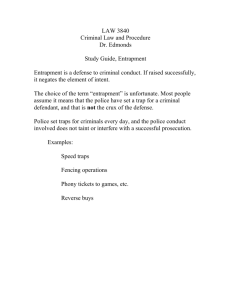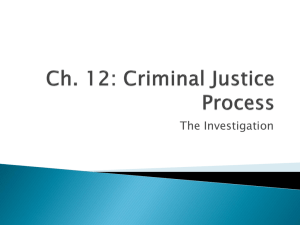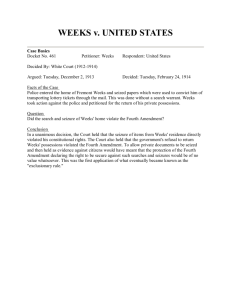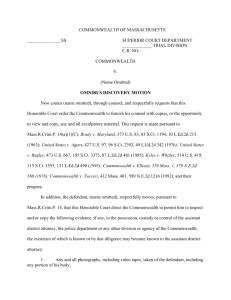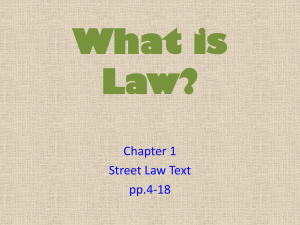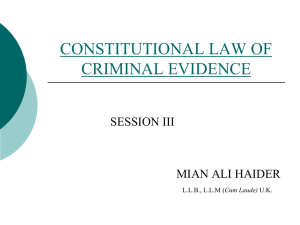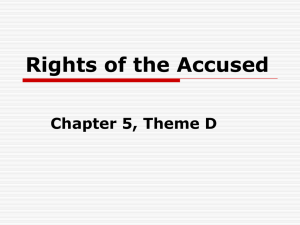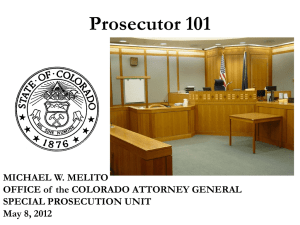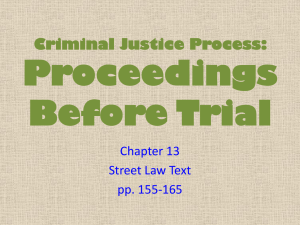The Exclusionary Rule and Entrapment
advertisement
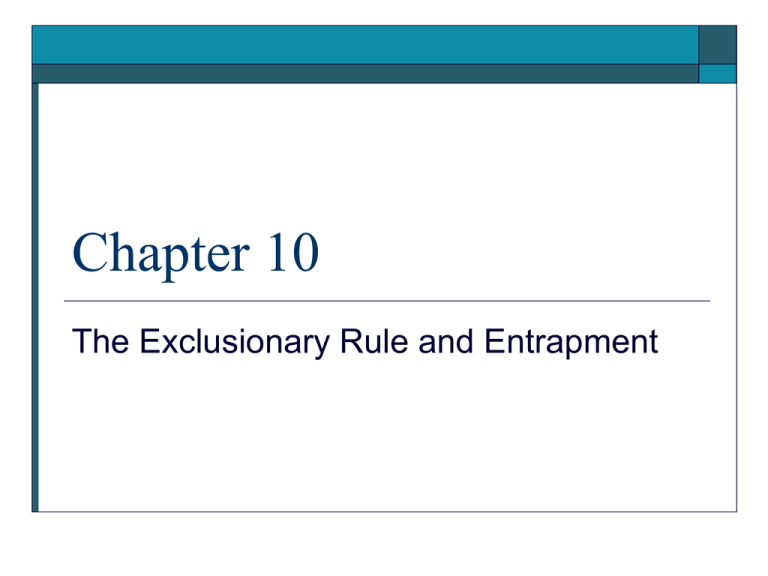
Chapter 10 The Exclusionary Rule and Entrapment Exclusionary Rule provides that evidence that is obtained as a result of a violation of the Fourth Amendment prohibition on unreasonable searches and seizures is inadmissible in a criminal prosecution to establish a defendant’s guilt derivative evidence evidence that is discovered as a result of the unlawfully seized evidence is also excluded from evidence fruit of the poisonous tree Exclusionary Rule (cont.) Wolf v. Colorado: incorporated the Fourth Amendment to the states Elkins v. United States: eliminated the silver platter doctrine Mapp incorporated the exclusionary rule United States v. Calandra: the exclusionary rule is “a judicially created remedy designed to safeguard Fourth Amendment rights generally through its deterrent effect rather than a personal constitutional right of the party aggrieved” Arguments For Justice Tom Clark, Mapp v. Ohio Elkins v. United States Supreme Court Justice Louis Brandeis, dissent in Olmsted v. United States the cost of excluding evidence has led police departments to stress the importance of police professionalism a relatively small proportion of cases lead to the acquittal of defendants based on the exclusion of evidence Arguments Against the exclusionary rule is a “judicially created remedy;” judges are free to limit or even abolish the exclusionary rule Chief Justice Warren Burger, Bivens v. Six Unknown Named Agents decreases respect for the judiciary by requiring courts to take the side of defendants rather than victims undermines the purpose of a criminal trial evidence is suppressed regardless of whether the police committed a technical violation of the law or engaged in a blatant violation has no impact on the police in those instances in which the police seize a gun or drugs in order to remove the contraband from the streets and have no intention of pursuing a criminal prosecution Alternatives civil tort suits for damages against police officers who have engaged in unreasonable searches and seizures and the government criminal prosecution of the police for violation of civil liberties police administrative procedures subjecting officers to penalties a civilian review board that examines cases of suspected abuse a judicial hearing conducted prior to the prosecution of the criminal charge Invoking the Exclusionary Rule initial steps the first step in challenging the reasonableness of a search to file a pretrial motion to suppress most states and the federal courts place the burden of proof on the defendant when the search or seizure is based on a warrant the burden of proof is shifted to the government when the police act without a warrant if the trial judge decides to admit the evidence at trial and the defendant is convicted, the defense may appeal and raise the issue of whether the judge made the correct decision in admitting the evidence Invoking (cont.) Chapman v. California harmless error requires that the prosecution establish beyond a reasonable doubt that there is no reasonable probability that the evidence influenced the outcome of the trial habeas corpus Alderman v. United States standing whether the defendant has both a subjective and an objectively reasonable expectation of privacy in the area that is subject to the search burden of proof typically is placed on the defendant Exceptions based on a determination that the modest amount of additional deterrence to be gained from excluding the evidence from trial is outweighed by the cost to society of excluding the evidence from trial collateral proceedings attenuation Good Faith Exception objectively reasonable Justice Byron White, dissent in Stone v. Powell United States v. Leon: Court recognized the good faith exception Massachusetts v. Sheppard Illinois v. Krull Arizona v. Evans Illinois v. Rodriguez Other Exceptions independent source inevitable discovery Silverthorne Lumber Company v. United States Murray v. State Murray v. State impeachment Walder v. United States Harris v. New York Illinois v. James Legal Equations Effectiveness Thomas Davies “nonprosecution and/or nonconviction” of cases by the police, prosecutors, and judges based on the illegal seizure of evidence is “in the range of 0.6% to 2.35% “ of all felony arrests while these “loss rates” are not “trivial,” that they do not amount to a “major impact” on the criminal justice system Davies’ findings are backed by Peter Nardulli and others Entrapment Sorrells v. United States: the “conception and planning of an offense by an officer, and his procurement of its commission by one who would not have perpetrated it except for the trickery, persuasion, or fraud of the officer” the government’s inducement of an otherwise innocent individual to commit a crime Arguments For certain crimes are difficult to investigate and to prevent without using informants undercover techniques can result in a large number of arrests without the expenditure of substantial resources individuals will be deterred from criminal activity by the threat of government involvement in the crime the government may “manufacture Arguments Against crime” by individuals who otherwise may not engage in criminal activity the government may lose respect by engaging in law breaking informants who are employed by the government to infiltrate criminal organizations may be criminals whose own illicit activity often is overlooked in exchange for their assistance innocent individuals are approached in order to test their moral virtue by Law of Entrapment balance the need of law enforcement to rely on undercover techniques against the interest in ensuring that innocent individuals are not pressured or tricked into illegal activity Sherman v. United States subjective objective Subjective Test for Entrapment focuses on the defendant asks whether the accused possessed the criminal intent or “predisposition” to commit the crime or whether the government “created” the crime “but for” the actions of the government, would the accused have broken the law? two steps determine whether the government induced the crime evaluate whether the defendant possessed a “predisposition” to commit the crime with which he/she is charged followed by the federal government and most states Objective Test for Entrapment focuses on the conduct of the government Justice Felix Frankfurter, dissent: the crucial question is “whether police conduct revealed in the particular case falls below standards to which common feelings respond, for the proper use of governmental power” followed by the Model Penal Code and a minority of states Due Process Test for Entrapment the government’s conduct was so unfair and outrageous that it violates the Due Process Clause of the Fifth and Fourteenth Amendments to the U.S. Constitution, and it therefore would be unjust to convict the defendant U.S. Supreme Court rejected this test in United States v. Russell Legal Equations Invoking Entrapment affirmative defense in jurisdictions that follow the subjective approach, the defendant generally is required to establish the fact of inducement by a government agent after which the burden then shifts to the government to counter the defense by establishing the defendant’s “predisposition” beyond a reasonable doubt in jurisdictions that follow have adopted the objective test the burden of production of evidence and persuasion is placed on the defendant
